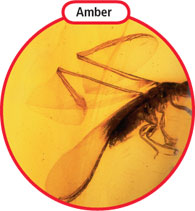Saturday Feb. 24,2018
This week we will study the different kinds of Fossils.
I will upload a video and the lesson from the book to help you understand the lesson.
Lesson 3: What Are Fossils?
Vocabulary
Fossils
Think about the “fossils” you made in the Investigate. Did they look like the shell you used? How were they different from the shell? A fossil is a trace or the remains of a living thing that died a long time ago. There are many different kinds of fossils.
Some fossils, such as bones and teeth, look like the actual parts of animals. Slowly minerals replaced the bones.
Other fossils, such as dinosaur tracks in mud, are only marks left behind. These marks are called imprints. The mud hardened, and in time it changed to rock. Some imprints are of animal parts, such as feathers. Other imprints are of leaves
A mold is the shape of a once-living thing left in sediment when
the rock formed. The organism that made the mold dissolved, leaving only a cavity
shaped like the organism.
A cast forms when mud or minerals later fill a mold. The cast has
the actual shape of the organism itself. You made a model of a fossil mold and
a fossil cast in the Investigate.
Plant fossils are not as common as animal fossils. That’s because
the soft parts of plants are easily destroyed as rocks form.
MAIN
IDEA AND DETAILS What are three
kinds of fossils?
This fossil shows a trilobite, a
kind of animal that died out more than 200 million years ago.
This fossil shows a trilobite, a
kind of animal that died out more than 200 million years ago.
|
How Fossils Form
Places
that have a lot of sedimentary rocks are better for fossil hunting than other
places. Why? It’s because what’s left of a once-living thing is sometimes
buried in the particles that form sedimentary rock. Fossils often form in
limestone and shale.
Few
fossils form in metamorphic and igneous rock. The pressure and temperature that
form these rocks often destroy plant and animal parts before they can become
fossils.
The Science Up Close shows how a fossil might have begun forming
millions of years ago. After dying, the animal was quickly covered by layers of
sediment. If the animal had not been covered quickly, another animal might have
eaten it. After millions of years, the layers of sediment became sedimentary
rock. What was left of the animal is now a fossil.
MAIN
IDEA AND DETAILS Why are more
fossils found in sedimentary rocks than in other rocks?
|
This
shows what the triceratops fossil below might look like
What can a scientist tell
about this fossil?
Learning from Fossils
Scientists
today use fossils to learn about animals and plants that no longer exist. For
example, scientists learn what kind of foods animals ate by looking at the
shapes of fossil teeth. The teeth are compared to those of today’s animals.
Fossils
also help scientists tell what a place was like long ago. For example, fossil
clams in a place show that a sea once covered the area.
Why do scientists dig up dinosaurs very
carefully?







No comments:
Post a Comment